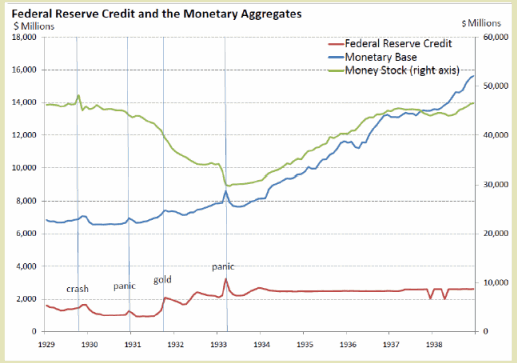Deflationists' Wrong in Both Theory and Historical Fact
Economics / Deflation Aug 03, 2012 - 04:21 AM GMTBy: Gary_North
An inflationist is someone who believes that price inflation is the result of two things: (1) monetary inflation and (2) central bank policy.
A deflationist is someone who believes that deflation is inevitable, despite (1) monetary inflation and (2) central bank policy.
No inflationist says that price inflation is inevitable. Every deflationist says that price deflation is inevitable.
Deflationists have been wrong ever since 1933.
Milton Friedman is most famous for his book, A Monetary History of the United States (1963), which relies on facts collected by Anna Schwartz, who died recently.
It is for one argument: the Federal Reserve caused the Great Depression because it refused to inflate.
This argument, as quoted by mainstream economists, is factually wrong.
I often cite a study, where you can see that the monetary base grew under the Federal Reserve, 1931 to 1932. This graph is from a speech given by the Vice President of the Federal Reserve Bank of St. Louis. You can access it here.

I posted this first in early 2010.
We can see that there was monetary deflation of the money supply, beginning in 1930. This continued in 1931 and 1932, despite a deliberate policy of inflation by the FED, beginning in the second half of 1931 and continuing through 1932.
Depositors kept pulling currency out of banks and hoarding it. They did not re-deposit it in other banks. This imploded the fractional reserve banking process for the banking system as a whole. M1 declined: monetary deflation.
The FED could not control M1. It could only control the monetary base.
The argument of Friedman and Schwartz was picked up by mainstream economists. It is his most famous and widely accepted position. Bernanke praised him for it on Friedman's 90th birthday in 2002.
Why was the argument wrong, as applied to 1931-33? I must tell the story one more time. Four letters tell it: FDIC. Well, nine: FDIC + FSLIC. They did not exist.
Franklin Roosevelt froze all bank deposits in early March 1933, immediately after his inauguration. This calmed the public when the banks re-opened a few days later. Her verbally promised people that the banks were now safe.
The U.S. government created federal bank depositor insurance in 1933. The Wikipedia article describes the Banking Act of 1933, which was signed into law in June.
- Established the FDIC as a temporary government corporation
- Gave the FDIC authority to provide deposit insurance to banks
- Gave the FDIC the authority to regulate and supervise state non-member banks
- Funded the FDIC with initial loans of $289 million through the U.S. Treasury
That stopped the bank runs. The money supply reversed. It went ballistic. So did the monetary base.
The key event was therefore the Banking Act of 1933. After that, the money supply never fell again. After that, prices never fell again by more than one percent. That was in 1955.
All it took for prices to reverse and rise was this: an expansion of the monetary base coupled with bank lending.
Gary North [send him mail ] is the author of Mises on Money . Visit http://www.garynorth.com . He is also the author of a free 20-volume series, An Economic Commentary on the Bible .
© 2012 Copyright Gary North / LewRockwell.com - All Rights Reserved
Disclaimer: The above is a matter of opinion provided for general information purposes only and is not intended as investment advice. Information and analysis above are derived from sources and utilising methods believed to be reliable, but we cannot accept responsibility for any losses you may incur as a result of this analysis. Individuals should consult with their personal financial advisors.
© 2005-2022 http://www.MarketOracle.co.uk - The Market Oracle is a FREE Daily Financial Markets Analysis & Forecasting online publication.



